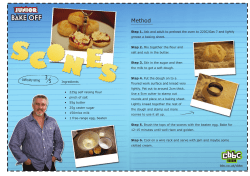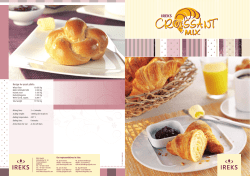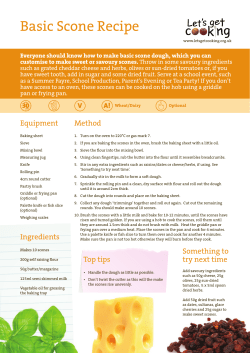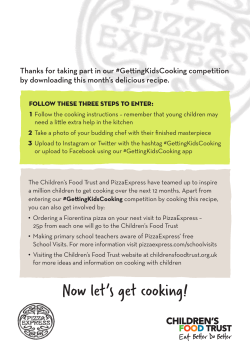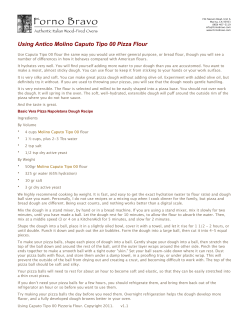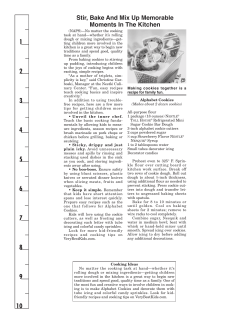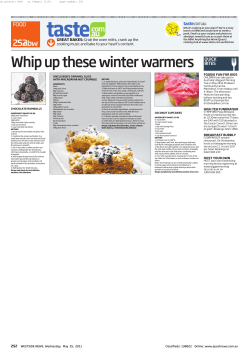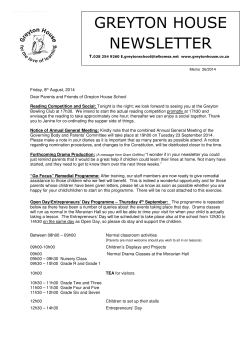
Classic recipes and top tips to help you Get Baking Sandwich, Scones,
Classic recipes and top tips to help you Get Baking Recipes for Victoria Sandwich, Scones, Cob Bread, Lemon Soufflés and Cornish Pasties Baking is a great British tradition – it is relaxing, rewarding and great fun. When we were making the BBC Two series The Great British Bake Off, we tasted cake, bread and biscuits from all over the UK and were delighted to find that baking is more popular than ever. Paul Hollywood and Mary Berry Nothing beats the taste of something that’s been baked at home, and it’s really not difficult. With a good recipe and some practice you’ll be amazed at what you can create. This guide will help you get started with five classic recipes and step-by-step advice. Learn how to make the perfect Victoria Sandwich, tasty Scones, a crusty Cob Loaf, hot Lemon Soufflés, or delicious Cornish Pasties. The recipes here were attempted by contestants on The Great British Bake Off and they’re the perfect introduction to baking. Find out about the essential elements of great baking and learn how to get brilliant results with some of our top baking tips. And if you’re a complete beginner, go online and let us show you how it’s done. Once you’ve built your confidence, we hope you’ll use your new baking skills to raise money for BBC Children in Need. Whether you hold a cake stall or a cake auction, you can help make a difference for children across the UK. So if you’re crazy for cake, can’t resist a biscuit, have a soft spot for bread, a passion for puddings or can’t get enough pies, there are no excuses – Get Baking! Get Baking for BBC Children in Need bbc.co.uk/food Contents Victoria Sandwich Scones Cob Loaf Lemon Soufflés Cornish Pasties Ask the Experts Bake it Better 3 7 11 15 19 22 24 All the recipes in this guide have step-by-step advice to help you bake beautifully. Remember the three golden rules: 1. Read the recipe through before you start. 2. Weigh and measure your ingredients carefully. 3. Don’t open the oven door while you’re baking. And for extra help, go online to watch Mary and Paul demonstrating the recipes and techniques: bbc.co.uk/food Before you start, it’s worth checking that you have some basic baking equipment: • Scales • Big and small mixing bowls • Wooden spoon • Tablespoon • Teaspoon • Whisk • Rolling pin • Oven gloves or thick tea towel • Spatula • Sieve 1 Ovens All ovens vary and the number on the dial isn’t always the true temperature – so cooking times can only be used as a guide. An oven thermometer is a good tool. Conventional and gas ovens are hottest at the top, so it’s best to bake on the middle shelf to avoid burning things before they’re cooked through. If your cakes start to brown too quickly, you can reduce the oven temperature by 10°C or, towards the end of the cooking time, you can cover them loosely with aluminium foil. Fan ovens provide a fiercer heat than conventional ovens, so reduce the temperature by 20°C – check your oven instruction booklet. Don't be tempted to open the oven door until at least two thirds through a cake’s cooking time – the structure of the batter won’t be 'set' before this stage and the sudden change in temperature can cause it to collapse. If you need to look after this point, open the door a crack and shut it as gently as possible to minimise any change in temperature or blasts of cold air. 2 Butter, Spreads and packet Margarine Fats like butter, spreads and packet margarine incorporate air bubbles in cake batters to make them rise, give a crumbly or flaky texture to pastry, and increase the lightness of a loaf. They also give taste, adding richness and moistness to the finished recipe. Butter is made from animal fat (milk), while margarine, baking spread and vegetable spreads are made from blends of animal and vegetable oils, or just vegetable oils. Vegetable spreads are lower in saturated fats. Always check on the pack that a vegetable spread is suitable for baking because many of the lighter or cholesterol-lowering versions won't work as well. Baking spread gives excellent results in cakes – choose a spread with a minimum 58% fat. If you prefer to use butter or packet margarine, it’s important that it’s at the right consistency – it should be soft and squishy but not oily. Mary Berry’s Perfect Victoria Sandwich The traditional Victoria Sandwich is a baking classic and a tasty teatime treat. This ‘all-in-one’ method is quick and easy. Very Easy Preparation Preparation time: about 30 minutes Cooking time: about 25 minutes Makes: 12 slices Ingredients •4 large free-range eggs •225g/8oz caster sugar, plus a little extra for the finished cake •225g/8oz self-raising flour •2 level tsp baking powder •225g/8oz baking spread or soft butter at room temperature, plus a little extra to grease the tins •Good-quality strawberry or raspberry jam •Whipped cream (optional) EQuipment •Scales •2 x 20cm or 8in round tins •Baking parchment or greaseproof paper •Large mixing bowl •Electric hand mixer or wooden spoon •Damp cloth •Spatula •Palette knife or flat knife •Clean tea towel •Cooling rack 4 Method Stage one 1. Weigh out the ingredients. 2. Preheat the oven to 180°C (160°C fan assisted)/ 350F/Gas 4. 3. Grease and line the sandwich tins – use a piece of baking parchment or greaseproof paper to rub a little baking spread or butter around the inside of the tins until the sides and base are lightly coated. Line the bottom of the tins with a circle of baking parchment or greaseproof paper (draw around the base of the tin onto the parchment and cut out a circle to fit). 4. Break the eggs into a large mixing bowl, then add the sugar, flour, baking powder and baking spread. Make sure the teaspoons of baking powder are level, not heaped, as too much baking powder can make the cake sink. 5. Mix everything together until well combined. The easiest way to do this is with an electric hand mixer, but you can use a wooden spoon. Put a damp cloth under your bowl when you’re mixing to stop it moving around. Be careful not to over-mix. 6. Divide the mixture evenly between the tins – this doesn’t need to be exact, but you can weigh the filled tins if you want to check. Use the spatula to remove all of the mixture from the bowl and gently smooth the surface of the cakes. 7. Place the tins on the middle shelf of the oven and bake for about 25 minutes. Don’t be tempted to open the door while they’re cooking, but after 20 minutes look through the door to check them. TOP TIP The finished cake mixture should be a soft ‘dropping’ consistency and should fall off a spoon easily. Be careful not to over-mix – as soon as everything is blended you should stop. Stage two 8. The cakes are done when they’re pale golden-brown and coming away from the edge of the tins. Press them lightly with a finger to check – they should spring back. Remove them from the oven and set aside to cool in their tins for 5 to 10 minutes. Then run a palette or flat knife around the edge of the tin and carefully tip the cakes out onto a cooling rack. To take your cakes out of the tins without leaving a wire rack mark, put a clean tea towel over the tin, put your hand onto the tea towel and tip the tin upside down. The cake should come out onto your hand and the tea towel – then you can turn it from your hand onto the wire rack. 9. Set aside to cool completely. Stage three 10.To assemble the cake, place one cake upside down onto a plate and spread it with plenty of jam. If you want to, you can add whipped cream too. 11. Top with the second cake, top side up. Sprinkle over the caster sugar. 5 Raising Agents Milk Baking powder and bicarbonate of soda are chemical raising agents (as opposed to yeast, which is a fungus). They give sponges, scones, muffins and some biscuits their light texture. Milk and cream are added to slacken the consistency, give a lighter result and add protein and fat. Milk is also used in bread to add a richness and a slight sweetness, but it should be scalded (almost boiled) and cooled beforehand to prevent the bread having a heavy crumb. Active raising agents give off bubbles of carbon dioxide, which help batter or dough rise. Once they reach a certain temperature in the oven they stop working and the batter or dough sets. It's important not to open the oven door too early during cake baking – the batter needs to set around the air bubbles first or the cake will collapse. Bicarbonate of soda is alkaline and needs an acid to get it working. Yoghurt, buttermilk and cream of tartar are commonly used to do this. Baking powder is a ready mix of bicarbonate of soda and an acid. It’s inactive as long as it’s dry and starts working when it comes into contact with liquids. Once opened, raising agents have a limited shelf life. To test if they're still active, add a teaspoon of raising agent to a small bowl of water – if it doesn’t bubble and fizz, throw it away. 6 Full-fat cow's milk is normally used in recipes, but semi-skimmed will work, although the result will be less creamy. Avoid using skimmed milk as it’s too watery for baking. Part or all of the milk can be replaced with cream for a richer result – this works particularly well in scones. Goat's milk, sheep's milk and non-dairy alternatives such as soya or rice milk can be substituted in most recipes, but check the label as some brands may be unsuitable for baking. Whipped cream is used as a filling or topping. Always use double or whipping cream as these have a higher fat content. Single cream won't whip. When whipping cream, stop as soon as soft peaks form – if you whip for too long, the cream will turn to butter. Paul Hollywood’s Scones This simple recipe will give you soft and fluffy scones – perfect with jam and plenty of clotted cream. Easy Preparation Preparation time: about 30 minutes Cooking time: 10–15 minutes Makes: about 8 large scones Ingredients •500g/1lb 1oz strong bread flour, plus a little extra for rolling out •80g/3oz softened butter, plus a little extra to grease the baking tray •80g/3oz caster sugar •2 eggs •25g/5 level tsp baking powder •250ml/81/2fl oz milk •1 free-range egg, beaten with a little salt (for glazing) •Butter •Good-quality strawberry or raspberry jam •Clotted cream EQuipment • Scales • Flat baking tray • Wooden spoon •Baking parchment or silicone paper (not greaseproof) • Round pastry cutter (about 7.5cm/3in wide) • Rolling pin • Pastry brush • Cooling rack 8 Method 1. Weigh out the ingredients. 2. Preheat the oven to 220°C (200°C fan assisted)/ 425F/Gas 7. 3. Lightly butter and line a baking tray with baking parchment or silicone paper. 4. Put 450g/151/2oz of the flour into a large bowl and add the butter. Rub the flour and butter together with your fingers to create a crumble/breadcrumb-like mixture. 5. Add the sugar, eggs and baking powder and use a wooden spoon to turn the mixture gently. Make sure you mix all the way down to the bottom and incorporate all of the ingredients. 6. Now add half of the milk and keep turning the mixture gently with the spoon to combine. Then add the remaining milk a little at a time and bring everything together into a very soft, wet dough. You may not need to add all of the milk. 7. Put most of the remaining flour onto a clean work surface. Tip the soft dough onto the flour and sprinkle the rest of the flour on top. The mixture will be wet and sticky. 8. Lightly chaff the mixture – use your hands to fold the dough in half, and then turn the dough a quarter turn and repeat. By folding and turning the mixture in this way, you incorporate the last of the flour and add air. Do this a few times until you’ve formed a smooth dough. If the mixture is too sticky use some extra flour to coat your hands or the mixture to make it more manageable. Be careful not to overwork your dough. TOP TIP Dip the edge of the pastry cutter in flour to make it easier to cut out the scones without them sticking. Don’t twist the cutter – this makes the scones rise unevenly – just press firmly, then lift up and push the dough out. 9. Next roll the dough out – sprinkle flour onto the work surface and the top of the dough. Use the rolling pin to roll up from the middle and then down from the middle. Turn the dough a quarter turn and repeat until it’s about 2.5cm/1in thick. Relax the dough slightly by lifting the edges and allowing the dough to spring back. 10.Using a pastry cutter, stamp out rounds and place them onto the baking tray. Once you’ve cut 4 or 5 rounds you can re-work and re-roll the dough to make it easier to cut out the remaining rounds. Any left-over dough can be worked and rolled again, but the resulting scones won’t be as fluffy. 11. Place the scones on the baking tray and leave them to rest for a few minutes to let the baking powder work. Then use a pastry brush (or your finger if you don’t have a brush) to glaze them with the beaten egg and salt mixture. Be careful to keep the glaze on the top of the scones. If it runs down the sides it will stop them rising evenly. 12.Bake in the middle of the oven for 15 minutes, or until the scones are risen and golden. 13.Leave the scones to cool, then split in half and add butter, jam and clotted cream to serve. 9 Flour Yeast It's important to choose the right flour for your recipe. Bread needs a strong flour with a high gluten content. Gluten is the protein that is stretched during kneading to give a soft, elastic dough and a well-risen loaf with a soft texture. Yeast is a single-cell fungus that is used to make bread rise. When yeast is given air and food (sugar and flour) in a warm environment (a standard kitchen as opposed to the fridge), the yeast will grow quickly and produce lots of carbon dioxide. It's this carbon dioxide that causes bread to rise. Yeast dies at 60°C, so once it’s done its job and the bread has risen, it’s killed off in the oven. A softer flour, lower in gluten and finely milled, is used to make cakes and pastry light and fluffy. Using a flour with a high gluten content makes cakes tough or rubbery. Softer flours are usually sold as plain flour or self-raising flour. Cake recipes that use plain flour will usually ask for the addition of baking powder or bicarbonate of soda. Self-raising flour is plain flour ready-mixed with raising agents. Wholemeal flour can be substituted for white flour, but will give a heavier result – try experimenting with half and half first. 10 Yeast flourishes at warm temperatures, around 35°C, so warm water should be used in dough to activate the yeast. If it's too hot it will kill the yeast. Yeast is also killed by direct contact with salt, which is why bread recipes normally say to mix the salt into the flour first to 'dilute' it, or to add the salt and yeast to opposite sides of the bowl. Yeast can be bought fresh or dried. Fresh yeast may be available in bakeries or at the bread counter in supermarkets. Dried yeast is sold as 'dried active yeast', which needs to be reactivated in warm water before using, or as 'quick' or 'instant' yeast, which can be added directly to flour in its dry form. Paul Hollywood’s Crusty Cob Loaf Making bread takes time, but it’s not difficult. Try Paul’s recipe for a delicious crusty loaf. Easy Preparation Preparation time: 2–3 hours Cooking time: 30 minutes Makes: 1 loaf Ingredients •500g/1lb 1oz strong white bread flour, plus a little extra flour for finishing •40g/11/2oz soft butter •12g/2 sachets fast action dried yeast •10g/2 tsp salt •About 300ml tepid water (warm not cold – about body temperature) •A little olive or sunflower oil •Additional cold water, for creating steam in the oven Equipment •Large mixing bowl •Flat baking tray •Old roasting tin •Clean tea towel •Baking parchment or silicone paper (not greaseproof) 12 Method Stage one 1. Weigh out the ingredients. 2. Put the flour into a large mixing bowl and add the butter. Add the yeast to one side of the bowl and add the salt to the other – the salt will kill the yeast if they come into direct contact. Stir all the ingredients with a spoon to combine. 3. Add half of the water and turn the mixture round with your fingers. Continue to add water a little at a time, combining well, until you’ve picked up all of the flour from the sides of the bowl. You may not need to add all of the water, or you may need to add a little more – you want a dough that is well combined and soft, but not sticky or soggy. Mix with your fingers to make sure all of the ingredients are combined and use the mixture to clean the inside of the bowl. Keep going until the mixture forms a rough dough. 4. Use about a teaspoon of oil to lightly grease a clean work surface – using oil instead of flour will keep the texture of the dough consistent. Put your dough onto the greased work surface. Make sure you have plenty of space. 5. Fold the far edge of the dough into the middle, then turn the dough by a quarter turn and repeat. Do this several times until the dough is very lightly coated in olive oil. 6. Now use your hands to knead the dough. Push the dough out in one direction with the heel of your hand, then fold it back on itself, turn the dough a quarter turn and repeat. Kneading in this way stretches the gluten and makes the dough elastic. Do this for about 4 or 5 minutes until the dough is smooth and stretchy. Work quickly so that the mixture doesn’t stick to your hands – if it does get too sticky you can add a little flour to your hands. 7. Clean and lightly oil your mixing bowl and put the dough back into it. Cover with a damp tea towel or lightly oiled cling film and leave it on one side to prove. This gives the yeast time to work and the dough will double in size. This should take about an hour, but will vary depending on the temperature of your room. TOP TIP Leave the dough to prove in a warm, but not hot place. In hot temperatures the yeast will work too quickly and your bread won’t have as much flavour. Stage two 8. Line a baking tray with baking parchment or silicone paper. 9. Once the dough has doubled in size you can scrape it out of the bowl to shape it. The texture should be bouncy and shiny. Put it onto a lightly floured surface and knock it back – use your hand to roll the dough up, then turn by a quarter turn and roll it up again. Repeat several times. Then use your hands to gently turn and smooth it into a round loaf shape. 10.Place onto the lined baking tray, cover with a tea towel or lightly oiled cling film and leave to prove again until it’s doubled in size. This will take about an hour, but may be quicker or slower depending on how warm your kitchen is. 11. Preheat the oven to 220°C (200°C fan assisted)/425F/ Gas 7. Put an old, empty roasting tin into the bottom of the oven. Stage three 12.After an hour the loaf should have risen again. Sprinkle some flour on top and very gently rub it in. Use a large, sharp knife to make shallow cuts about 1cm deep across the top of the loaf to create a diamond pattern. 13.Put the loaf on the baking tray into the middle of the oven. Pour cold water into the empty roasting tray at the bottom of the oven just before you shut the door – this creates steam which helps the loaf develop a crisp and shiny crust. 14.Bake the loaf for about 30 minutes. 15.The loaf is cooked when it’s risen and golden. To check, take it out of the oven and tap it gently underneath – it should sound hollow. Turn onto a wire rack to cool. 13 Eggs Sugar Eggs play different roles in baking. In cakes the whole eggs are used to bind ingredients together and make the cake rise. In a soufflé the yolks and whites are separated – the yolks are used to thicken a custard base and the whites are whisked to make the soufflé light. As well as providing sweetness in cakes and biscuits, sugar also encourages dough and batter to brown when they’re baked, giving a lovely golden colour and caramelised flavour. In bread a small amount of sugar will 'feed' the yeast and increase fermentation, but large quantities of sugar will slow down fermentation, which is why sweet bread can take a long time to rise. Too much sugar in a cake or biscuit can cause it to burn before it's cooked through. When whisked vigorously by hand, or with electric beaters, egg whites increase in volume to form soft, then stiff peaks. These whisked whites can be mixed with sugar to make meringues, or folded into a flour-based sauce to make soufflés. It's important to fold in whisked egg whites gently so that you don't knock out the air – this air is what gives the light and airy texture. Any speck of fat or yolk can prevent the whites from whisking to full volume, so it's important to use a clean whisk and bowl and avoid breaking any yolk into the whites. For this reason, it's a good idea to separate each egg into two small bowls, so that you can add the whites to a large mixing bowl, one at a time. Always use the size of eggs given by the recipe. 14 Refined sugars are sold as granulated (coarse), caster sugar (fine) and icing sugar (a fine powder). Caster sugar is best for most baking recipes and either white or golden can be used. Unrefined sugars have more flavour and range from dark muscovado sugar to light brown sugars. Icing sugar is used for dusting cakes, biscuits and soufflés, sweetening pastry or mixing with liquids or fats to make icing. Mary Berry’s Hot Lemon Soufflés Soufflés can be fiddly to make, but if you follow the recipe carefully you’ll get great results and a real sense of achievement. Intermediate Preparation Preparation time: about 30 minutes Cooking time: about 14 minutes Makes: 4 soufflés Ingredients •Melted butter for greasing •2 lemons, juice and zest •2 free-range egg yolks, plus 4 free-range egg whites •6 rounded tbsp caster sugar, plus extra for the ramekins •3 rounded tsp cornflour •1 rounded tbsp plain flour •90ml/31/4fl oz double cream •110ml/4fl oz full-fat milk •Icing sugar for dusting (optional) Equipment •Scales •4 medium-sized ramekins (150ml capacity) •Fine grater •Lemon squeezer •Baking tray •Large saucepan •One large, one medium and one small bowl •Wooden spoon •Hand whisk •Large metal spoon •Spatula or palette knife •Electric hand mixer 16 Method Stage one 1. Measure out the ingredients and remove the eggs from the fridge. 2. Brush the insides of four ramekins with butter. Add a small amount of sugar to each and turn them to coat the sides and bottom, shaking out any excess. Set aside to chill in the fridge. 3. Use a fine grater to zest the lemons – grate the yellow outer skin, but be careful not to grate the white pith underneath (the pith will make the soufflés bitter). Cut the lemons in half and squeeze the juice. Add the zest to the juice and put to one side. 4. Separate the eggs – crack each egg in half and tip the contents between the two shells, allowing the whites to slide through into the bowl beneath, while the yolks stay in the shells. 5. Put four egg whites into a large bowl and two of the yolks into a separate small bowl (the left-over egg yolks can be saved for scrambled eggs or custard). Add 6 tablespoons of sugar to the small bowl with the egg yolks. 6. Preheat the oven to 180°C (160°C fan assisted)/350F/ Gas 4. Put the baking tray into the middle of the oven. Stage two 7. Put the cream, flour and cornflour into a medium-sized bowl and whisk to a smooth paste. 8. Warm the milk in a large saucepan over a medium heat until just boiling. Remove from the heat. 9. Mix the hot milk into the cream, flour and cornflour mixture with the whisk – add a little to start with and mix well until the mixture is smooth like really thick cream. Press any lumps to the side to break them up. Then add the rest of the milk. 10.Pour the mixture back into the saucepan and put it over a gentle heat. Beat vigorously with a hand whisk until it’s thickened. It’s important to keep whisking all the time so that the mixture doesn’t stick. TOP TIP Fold in the egg whites very gently – the aim is to fold in the air bubbles without breaking them up. Use a metal spoon or spatula to go round the outside of the bowl and cut through the middle. 11. When you feel it thickening, remove the pan from the heat and whisk in the lemon juice and zest a little at a time. The heat of the pan will continue to cook the mixture. 12.Use a wooden spoon to beat the egg yolks and caster sugar together in the small bowl. Beat them into a thick paste. 13.Add this paste to the mixture in the saucepan and mix well until smooth. Put the saucepan back on the hob to thicken again. Whisk until it begins to bubble and then take it off the heat – the mixture should look like custard. Put it to one side to cool before adding the egg whites. Stage three 14.Make sure the bowl and whisk are completely clean and grease-free, and make sure there’s no yolk with the egg whites. Whisk the egg whites in a large bowl using an electric hand mixer, until soft peaks begin to form – the egg whites should look like clouds. 15.Check the temperature of the mixture in the saucepan before you add the egg whites – it should be body temperature or cooler. Add one large spoonful of the egg whites to the saucepan and beat well with the whisk to make the mixture less stiff. Now use a large metal spoon or spatula to gently fold in the remaining egg whites. Continue until it’s a pale yellow mixture with no streaks of egg white. 16.Fill the ramekins to the brim with the mixture and level off with a spatula or palette knife. Run a thumb nail around the inside rim of the ramekins (this helps the soufflés rise evenly without catching on the sides). 17. Place the ramekins on the baking tray in the middle of the oven for about 14 minutes until risen and turning golden. Don’t open the oven during cooking. Time and watch the soufflés carefully – take them out as soon as they’ve risen and are starting to go golden. If you’re using smaller ramekins you’ll need to reduce the cooking time by a few minutes (5 or 6 smaller soufflés will need about 10 minutes). 18.Dust with icing sugar and serve immediately. 17 Shortening, Lard and Suet Shortening is a general term for fats used in baking, but is normally used to refer to lard, made from pig fat. The vegetable equivalent is sold as vegetable shortening, white spread or vegetable fat and can be substituted for lard. They all have a high fat content of 90g–100g per 100g. Shortening is mostly used in pastry, and in some biscuits and cakes, to create a crumbly, 'melt-inthe-mouth' texture by breaking up gluten in the dough. It adds richness, but doesn’t have much flavour. To compensate for this, butter or margarine is often added. Suet, the fat taken from around the kidneys and loins in beef, is used in suet pastry, puddings and dumplings, savoury and sweet. The suet gives a moist texture that is light and dense. Vegetable suet is available and can be substituted for beef suet in all recipes. 18 Salt A pinch of salt is used in savoury baking to improve the flavour – it’s also sometimes used in sweet baking to enhance the sweetness. Salt is almost always added to bread made in the UK and any cook who forgets to add it to a basic loaf will notice as soon as they take a bite – it will be bland and won’t taste of bread as we know it. Too much salt inhibits yeast and leads to a flat, heavy loaf, so always follow a bread recipe carefully when it comes to salt quantities. Make sure the salt doesn’t come into direct contact with the yeast. When a recipe includes butter it's best to use an unsalted butter. Salted butters can vary in saltiness, and it’s easier to control the quantity by adding salt separately. Classic Cornish Pasties An all-in-one meal that’s portable and delicious. One of the advantages of this recipe is that you don’t need to cook the filling in advance – the meat and vegetables cook inside the pastry. Intermediate Preparation Preparation time: 2 hours Cooking time: 45 minutes Makes: 4 good-sized pasties Ingredients For the pastry •500g/1lb 1oz strong bread flour •120g/4oz white shortening •5g/1 tsp salt •25g/1oz margarine or butter •175ml/6fl oz cold water •1 free-range egg, beaten with a little salt For the filling •350g/12oz good quality beef skirt, rump steak or braising steak •350g/12oz waxy potato •200g/7oz swede •175g/6oz onion •Salt and freshly ground black pepper •Knob of butter or margarine Equipment •Scales •Large mixing bowl •Cling film •Baking tray •Spoon •Baking parchment or silicone paper (not greaseproof) •Rolling pin •Fork •Pastry brush 20 Method Stage one 1. Weigh out the ingredients. 2. Tip the flour into the bowl and add the shortening, the salt, the margarine or butter and all of the water. 3. Use a spoon to gently combine the ingredients. Then use your hands to crush everything together, bringing the ingredients into a dry dough. 4. Put the dough onto a clean work surface. 5. Work the dough to combine the ingredients properly. Use the heel of your hand to stretch and roll the dough. Roll it up – then turn it, stretch and roll it up again. Repeat this process for about 5 minutes. The dough will start to become smooth as the shortening breaks down. If the dough feels grainy, keep working until it’s smooth and glossy. Don’t be afraid to be rough – you’ll need to use lots of pressure and work the dough vigorously to get the best results. 6. When the dough is smooth, wrap it in cling film and put it in the fridge to rest for 30–60 minutes. Stage two 7. While the dough is resting, peel and cut the potato, swede and onion into cubes about 1cm square. Cut the beef into similar sized chunks. Put all four ingredients into a bowl and mix. Season well with salt and some freshly ground black pepper, then put the filling to one side until the dough is ready. 8. Lightly grease and line a baking tray with baking parchment or silicone paper. 9. Preheat the oven to 170°C (150°C fan assisted)/ 325F/Gas 3. TOP TIP This recipe gives a tight rather than a sticky dough, so there’s no need to put flour or oil onto the surface when you roll it out. Stage three 10.Once the dough has had time to relax, take it out of the fridge. The margarine or butter will have chilled, giving you a tight dough. Cut the dough into four equal-sized pieces. Shape each piece into a ball and use a rolling pin to roll each ball into a disk roughly 25cm/10in wide (roughly the same size as a dinner plate). 11. Spoon a quarter of the filling onto each disk. Put the filling on one half, leaving the other half clear. Put a knob of butter or margarine on top of the filling. 12.Carefully fold the pastry over, join the edges and push with your fingers to seal. Crimp the edge to make sure the filling is held inside – either by using a fork, or by making small twists along the sealed edge. When you’ve crimped along the edge, fold the end corners underneath. 13.Put the pasties onto the baking tray and brush the top of each pasty with the egg and salt mixture. Bake on the middle shelf of the oven for about 45 minutes or until the pasties are golden brown. If your pasties aren’t browning, you can increase the oven temperature by 10°C for the last 10 minutes of cooking time. With thanks to the Cornish Pasty Association 21 Q: Does it matter what size cake tins I use? A: Cake baking requires precision and this includes the size of the tins. Too big and your cake will be thin and cook too quickly, too small and your mixture will overflow as it rises. So always use the size of tin specified in the recipe. You can get away with a difference of about 1cm, but any more than that and you’ll need to adjust the baking time. A square tin will have a greater capacity than a round tin, so if you want to use a square tin, go down a size, e.g. an 18cm/ 7in square tin would be comparable to a 20cm/8in round tin. Q: Why is my cake heavy? A: Under-beating or over-beating the mixture can make a heavy cake. If your mixture is under-mixed there will be streaks of fat, an uneven colour and possibly some lumps. You need to beat a little more until it’s smooth. It’s hard to tell when a mixture is over-beaten, so stop as soon as it looks smooth, otherwise you can overwork the gluten in the flour, which will result in a tough, rubbery cake. Not enough raising agent can also make a cake heavy, but don’t be tempted to add more than the recipe says. 22 Q: Why has my cake sunk in the middle? A: Did you open the oven door before the cake was cooked? Never open the door until at least two thirds of the cooking time has passed and the mixture has set. Too much raising agent can also cause a cake to ‘over-rise’ then collapse on itself, so follow the recipe closely. Q: Why are my scones hard and dry? A: The most common reason is overworking the dough. You should chaff or fold rather than knead, to avoid stretching the gluten in the flour. Other reasons could be not adding enough liquid, using a raising agent that is too old and ineffective, or overcooking your scones. Q: Why hasn’t my soufflé risen? A: The whisked egg whites need to be beaten until stiff and folded in very gently otherwise the air gets knocked out and the soufflé won’t rise. Always put them into the pre-heated oven as quickly as possible and don’t open the oven door during cooking or they’ll collapse. If they’re not cooked properly when you take them out, they may sink. Paul Hollywood and Mary Berry Q: Why is my dough too sticky? A: You’ve probably added too much liquid. Gradually add just enough flour to make your dough manageable, but not too much or it will become dry. Dough can be stickier on hot days, so lightly coat your hands with flour or oil during kneading. Also check that you haven't forgotten to add the salt, as this can affect the consistency of your dough. Q: How long should I leave my bread to prove? A: The best way to tell if the dough has fully proved is to judge when it has almost doubled in size. When it has proved, it should be light to the touch and bounce back when you gently push it with your finger. Let your dough double in size, but don’t let it expand any further. If you let your bread rise too far, the structure can become weak and may collapse during baking. If you can’t bake it straight away, transfer it to the fridge where it can be left overnight. On the second proving, if the dough starts creasing on the sides it's a sign the dough has over-proved. If this happens you can knock back the dough and re-shape it (knocking back a second time actually improves the flavour). Q: Why is my bread heavy and stodgy? A: The answer is in your kneading. Kneading combines the ingredients, activates the yeast and develops the gluten which holds the loaf together. If you don’t knead enough the dough won’t hold pockets of air and will collapse, making bread heavy and dense. Another possibility is that it didn’t rise for long enough. Under-proved dough splits and has an uneven texture. If it’s tight, stodgy or doughy at the bottom it’s a sign that your dough hasn’t proved for long enough. When you’re proving, the dough should double in size then be knocked back (using your hands to punch out the air) and then allowed to double in size again before baking. Another reason could be that it needed longer in the oven. When cooked, bread sounds hollow if tapped underneath. Q: Why hasn’t my bread got a crusty top? A: Normally this is because the oven isn’t hot enough. Make sure you pre-heat your oven according to the recipe. Put a shallow tin of water in the bottom of the oven to create steam and help form a crisp crust. Recipe times are just a guideline as dough will prove at different speeds depending on the warmth of the room and the consistency of the dough. 23 Baking is a combination of ingredients and skills – the more you practise those skills, the better your baking will be. There are lots of short technique videos online to help you at bbc.co.uk/food Chaffing – mixing dough to incorporate air without over-working the gluten in the flour. Kneading Folding in – slowly incorporating flour or whisked egg whites into a mixture. Glazing – lightly coating pastry or dough with beaten egg or milk to give it a golden colour in the oven. Kneading – working dough to stretch the gluten and activate the yeast. The key to successful bread. Knocking back – knocking the air out of dough after it’s proved. Proving – leaving dough in a warm place to give the yeast time to work. Separating eggs Rubbing in – mixing flour and fat together with your fingers until it looks like breadcrumbs. Separating eggs – separating egg yolks from egg whites. This can be fiddly, but it’s useful in lots of recipes. Zesting and juicing – extracting the zest and juice of citrus fruit to add flavour to baking. Folding in 24 Bake it to the next level The five recipes in this booklet are just the start. Whether you want to celebrate a birthday, help raise money, or keep the kids entertained, there are lots of ways to make the most of your baking skills. You could start by adapting some of the recipes in this guide. Try adding sultanas to your scones, sprinkle seeds on your loaf, or turn your Victoria Sandwich into a birthday cake. For lots more baking recipes visit: bbc.co.uk/food Raising hundreds and thousands Baking is a great way to raise money for BBC Children in Need, so put your apron on for Pudsey and help make a difference for children across the UK. Go online for BBC Children in Need posters, fun bunting designs, and fundraising ideas: bbc.co.uk/food/getbaking Donating money to BBC Children in Need is very easy – find out how at: bbc.co.uk/pudsey Anyone can learn to bake – this guide will help you get started with five classic recipes and expert advice from Mary Berry and Paul Hollywood. bbc.co.uk/food With thanks to Mary Berry, Paul Hollywood, and Love Productions. Free downloadable versions of this guide are available in English and Welsh at: bbc.co.uk/food Published by BBC Learning Room MC4 A3 BBC Media Centre 201 Wood Lane London W12 7TQ © BBC 2010 Design: red-stone.com Home economist: Louisa Carter Recipe photography: Toby Scott Printed on 75% recycled paper
© Copyright 2025
